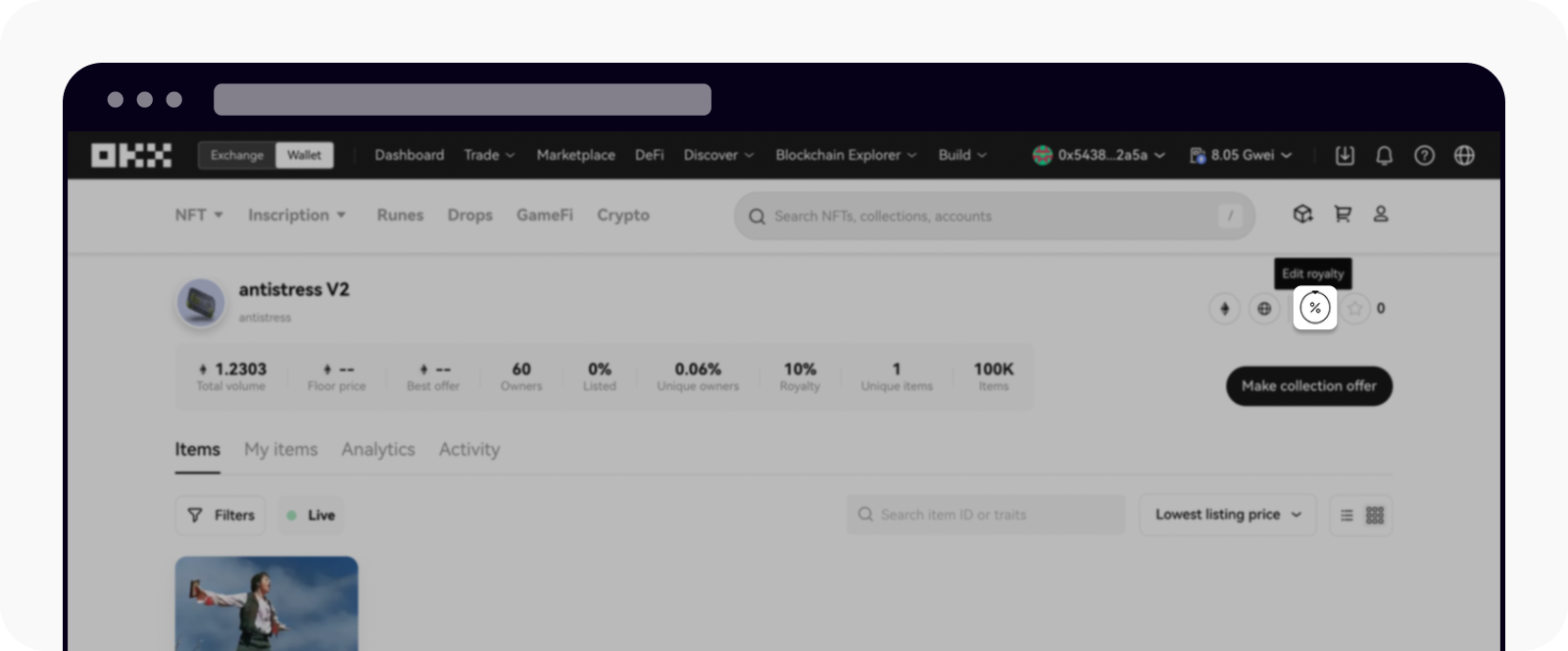Miten haen OKX Market Forced Royalty -sopimusta?
Miten haen OKX Market Forced Royalty -sopimusta?
Ennen kuin haet OKX Market Forced Royalty -sopimusta, varmista, että sinulla on:
Ottaa käyttöön tai päivittää NFT-sopimuksen
Lisää OKX Market -sopimuksen sallittujen luetteloon.
Määritä rojaltitiedot yhdistämällä sopimuksen hallintalompakko kokoelmasivuun ja valitsemalla Tee kokoelmatarjous asettaaksesi rojaltien vastaanotto-osoitteen ja kokoelmaprovision. Jos haluat muokata kokoelmasi tietoja, voit tutustua tähän artikkeliin EVM-verkossa oleville kokoelmille ja tähän artikkeliin koskien Ordinal-verkkoa.
Huomautus: Jos projektitiimin lompakko ei yhdisty markkinoille, voit ottaa yhteyttä markkinoiden tekniseen henkilökuntaamme konfigurointia varten.
Valitse Muokkaa rojaltia määrittääksesi rojaltien vastaanotto-osoitteen ja kokoelmaprovision
Varmista, että seuraavat tiedot täyttyvät, ennen kuin lähetät hakemuksesi tämän hakulomakkeen kautta:
Vain OKX:n tarjoamat sopimukset ovat vaihdettavissa (katso integrointiasiakirja)
Sopimuksilla muilta markkinoilta ei voi käydä kauppaa
Jos sallittujen luettelo avataan muille markkinoille, jotka eivät noudata pakotettua rojaltia, OKX pidättää oikeuden lopettaa eksklusiivisen keräyksen
Mitkä ovat sallittujen osoitteet eri ketjuissa?
Koostajajosoitteet, pakolliset rojaltimarkkinasopimusosoitteet ja yhtenäiset valtuutussopimusosoitteet ovat transaktioihin liittyviä osoitteita, jotka on määritettävä.
Eräsiirtotyökalun osoite on OKX-työkaluosoite, joka on yhteensopiva ERC721:n ja ERC1155:n kanssa, ja sen konfigurointi on valinnainen.
Ketjut | Koostajaosoite (Vaaditaan) | Pakollinen rojaltimarkkinasopimus osoite (Vaaditaan) | Yhtenäinen valtuutussopimusosoite (Vaaditaan) | Eräsiirtotyökalun osoite (Valinnainen) |
ETH | 0xa7FD99748cE527eAdC0bDAc60cba8a4eF4090f7c | 0x82C0fDFA607d9aFbe82Db5cBD103D1a4D5a43B77 | 0x2B45c083c9cAb7edA8d2d63B926d9A828EE01c74 | 0x5B93A825829f4B7B5177c259Edc22b63d6E4e380 |
Polygon | 0xa7FD99748cE527eAdC0bDAc60cba8a4eF4090f7c | 0xdc8B1f859bD9aFd93159DEcF75eaDD5f871aE6ee | 0x2B45c083c9cAb7edA8d2d63B926d9A828EE01c74 | 0x8325A52a1B74Cd50B4CcF94dD821F56A7a9018E2 |
ARB | 0xa7FD99748cE527eAdC0bDAc60cba8a4eF4090f7c | 0xdc8B1f859bD9aFd93159DEcF75eaDD5f871aE6ee | 0x2B45c083c9cAb7edA8d2d63B926d9A828EE01c74 | 0xdc426b528377F3Bd301D09FA0Ea16ff169cC8C73 |
BNB | 0xa7FD99748cE527eAdC0bDAc60cba8a4eF4090f7c | 0xdc8B1f859bD9aFd93159DEcF75eaDD5f871aE6ee | 0x2B45c083c9cAb7edA8d2d63B926d9A828EE01c74 | 0x6A5Cf9D9d0B8c32610b2a2e60cBb766D3404C3c6 |
Mode | 0xa7FD99748cE527eAdC0bDAc60cba8a4eF4090f7c | 0x2Cc7a0Ab3CD788d4C59A31d7C4001351Fb1CE564 | 0x2B45c083c9cAb7edA8d2d63B926d9A828EE01c74 | 0x5F47bfAD0d500A999b6A937e8D1715Db0B573631 |
X Layer | 0xa7FD99748cE527eAdC0bDAc60cba8a4eF4090f7c | 0xEfcB1C65C1fff1BDE5938505137AddA08c02713B | 0x2B45c083c9cAb7edA8d2d63B926d9A828EE01c74 | 0x08E4a58C6434f3d59d3D608596cFc3Cb95ef3329 |
Mitkä ovat viitekoodit?
Tässä ovat koodit, joihin voit viitata:
Kokoelman osalta voit käyttää esimerkkinä Openzeppelin 4.9 standardin toteutusta.
JavaScriptfunction _beforeTokenTransfer( address from, address to, uint256 tokenId ) internal virtual { if (_isContract(msg.sender)) { require(senderAllowlist[msg.sender], "Sender not in Allowlist"); } // ... ... // ... ... }Avoimen lähdekoodin osalta voit viitata esimerkkinä tähän linkkiin.
